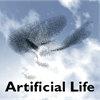二元细胞自动机中自复制分层结构的出现
IF 1.5
4区 计算机科学
Q4 COMPUTER SCIENCE, ARTIFICIAL INTELLIGENCE
引用次数: 0
摘要
我们发现了一种新颖的二元细胞自动机(CA)过渡规则,它能从稀疏的随机初始条件中产生跨越两个空间和时间尺度的自我复制结构。低级的、形状可变的细胞簇经常遵循瞬态吸引子轨迹,产生新的细胞簇,其中一些细胞簇会周期性地自我复制。当活细胞的初始分布足够稀疏时,这些细胞簇会凝聚成更大的形态,这些形态也会自我复制。这些形态可能会进一步形成规模更大的扩展复合体的边界。这种被称为 "离群者 "的规则是旋转对称的,适用于二维摩尔邻域。它是在广泛寻找促进 CA 开放式进化的规则的过程中,通过遗传编程进化而来的。在二元CA中,人们已经通过有意设计的状态集创建了自我复制结构,包括精心制作的和突发的结构,而 "离群者 "可能是第一个在二元CA中促进跨越两个空间尺度的非难突发自我复制的已知规则。本文章由计算机程序翻译,如有差异,请以英文原文为准。
Emergence of Self-Replicating Hierarchical Structures in a Binary Cellular Automaton
We have discovered a novel transition rule for binary cellular automata (CAs) that yields self-replicating structures across two spatial and temporal scales from sparse random initial conditions. Lower-level, shape-shifting clusters frequently follow a transient attractor trajectory, generating new clusters, some of which periodically self-duplicate. When the initial distribution of live cells is sufficiently sparse, these clusters coalesce into larger formations that also self-replicate. These formations may further form the boundaries of an expanding complex on an even larger scale. This rule, dubbed “Outlier,” is rotationally symmetric and applies to 2-D Moore neighborhoods. It was evolved through genetic programming during an extensive search for rules that foster open-ended evolution in CAs. While self-replicating structures, both crafted and emergent, have been created in CAs with state sets intentionally designed for this purpose, the Outlier may be the first known rule to facilitate nontrivial emergent self-replication across two spatial scales in binary CAs.
求助全文
通过发布文献求助,成功后即可免费获取论文全文。
去求助
来源期刊

Artificial Life
工程技术-计算机:理论方法
CiteScore
4.70
自引率
7.70%
发文量
38
审稿时长
>12 weeks
期刊介绍:
Artificial Life, launched in the fall of 1993, has become the unifying forum for the exchange of scientific information on the study of artificial systems that exhibit the behavioral characteristics of natural living systems, through the synthesis or simulation using computational (software), robotic (hardware), and/or physicochemical (wetware) means. Each issue features cutting-edge research on artificial life that advances the state-of-the-art of our knowledge about various aspects of living systems such as:
Artificial chemistry and the origins of life
Self-assembly, growth, and development
Self-replication and self-repair
Systems and synthetic biology
Perception, cognition, and behavior
Embodiment and enactivism
Collective behaviors of swarms
Evolutionary and ecological dynamics
Open-endedness and creativity
Social organization and cultural evolution
Societal and technological implications
Philosophy and aesthetics
Applications to biology, medicine, business, education, or entertainment.
 求助内容:
求助内容: 应助结果提醒方式:
应助结果提醒方式:


